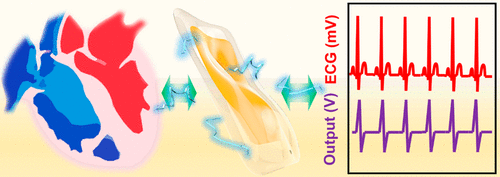当前位置:
X-MOL 学术
›
Acc. Mater. Res.
›
论文详情
Our official English website, www.x-mol.net, welcomes your
feedback! (Note: you will need to create a separate account there.)
Materials Perspectives for Self-Powered Cardiac Implantable Electronic Devices toward Clinical Translation
Accounts of Materials Research ( IF 14.0 ) Pub Date : 2021-08-23 , DOI: 10.1021/accountsmr.1c00078 Jun Li 1 , Xudong Wang 1
Accounts of Materials Research ( IF 14.0 ) Pub Date : 2021-08-23 , DOI: 10.1021/accountsmr.1c00078 Jun Li 1 , Xudong Wang 1
Affiliation

|
Represented by pacemakers, implantable electronic devices (CIEDs) are playing a vital life-saving role in modern society. Although the current CIEDs are evolving quickly in terms of performance, safety, and miniaturization, the bulky and rigid battery creates the largest hurdle toward further development of a soft system that can be attached and conform to tissues without causing undesirable physiologic changes. Over 50% of patients with pacemakers require additional surgery procedures to replace a drained battery. Abrupt battery malfunction and failure contributes up to 2.4% of implanted leadless pacemakers. The battery also has risks of lethal interference with diagnostic magnetic resonance imaging (MRI). Applying the implantable nanogenerators (i-NGs) technology to CIEDs is regarded as a promising solution to the battery challenge and enables self-powering capability. I-NGs based on the principle of either triboelectricity (TENG) or piezoelectricity (PENG) can convert biomechanical energy into electricity effectively. Meanwhile, a complete heartbeat cycle provides a biomechanical energy of ∼0.7 J or an average power of 0.93 W, which is sufficient for the operation of CIEDs considering the power consumption of 5–10 μW for a pacemaker and 10–100 μW for a cardiac defibrillator. It is therefore practical to leverage the effective, soft, flexible, lightweight, and biocompatible i-NGs to eliminate the bulky battery component in CIEDs and achieve self-sustainable operation. In this rapidly evolving interdisciplinary field, materials innovation acts as a cornerstone that frames the technology development. Here we bring a few critical perspectives regarding materials design and engineering, which are essential in leading the NG-powered CIEDs toward clinical translations. This Account starts with a brief introduction of the cardiac electrophysiology, as well as its short history to interface the state-of-the-art cardiac NG technologies. Three key components of NG-powered CIEDs are discussed in detail, including the NG device itself, the packaging material, and the stimulation electrodes. Cardiac NG is the essential component that converts heartbeat energy into electricity. It demands high-performance electromechanical coupling materials with long-term dynamic stability. The packaging material is critical to ensure a long-term stable operation of the device on a beating heart. Given the unique operation environment, a few criteria need to be considered in its development, including flexibility, biocompatibility, antifouling, hemocompatibility, and bioadhesion. The stimulation electrodes are the only material interfacing the heart tissue electrically. They should provide capacitive charge injection and mimic the soft and wet intrinsic tissues for the sake of stable biointerfaces. Driven by the rapid materials and device advancement, we envision that the evolution of NG-based CIEDs will quickly move from epicardiac to intracardiac, from single-function to multifunction, and with a minimal-invasive implantation procedure. This trend of development will open many research opportunities in emerging materials science and engineering, which will eventually lead the NG technology to a prevailing strategy for powering future CIEDs.
中文翻译:

面向临床转化的自供电心脏植入电子设备的材料前景
以心脏起搏器为代表的植入式电子设备(CIED)在现代社会中发挥着至关重要的救生作用。尽管当前的 CIED 在性能、安全性和小型化方面发展迅速,但体积庞大且坚硬的电池为进一步开发可以附着并符合组织而不引起不良生理变化的软系统造成了最大障碍。超过 50% 的起搏器患者需要额外的手术程序来更换耗尽的电池。突然的电池故障和故障占植入式无引线起搏器的 2.4%。该电池还存在对诊断磁共振成像 (MRI) 造成致命干扰的风险。将植入式纳米发电机 (i-NGs) 技术应用于 CIED 被认为是应对电池挑战的有希望的解决方案,并能够实现自供电能力。基于摩擦电 (TENG) 或压电 (PENG) 原理的 I-NG 可以有效地将生物机械能转化为电能。同时,一个完整的心跳周期提供约0.7 J的生物力学能量或0.93 W的平均功率,考虑到起搏器的功耗为5-10 μW,心脏的功耗为10-100 μW,这足以满足CIED的操作。除颤器。因此,利用有效、柔软、灵活、轻便和生物相容的 i-NG 来消除 CIED 中笨重的电池组件并实现自我可持续运行是切实可行的。在这个快速发展的跨学科领域,材料创新是技术发展的基石。在这里,我们提出了一些关于材料设计和工程的批判性观点,这些观点对于引领 NG 驱动的 CIED 走向临床转化至关重要。本报告首先简要介绍了心脏电生理学,以及它与最先进的心脏 NG 技术接口的短暂历史。详细讨论了 NG 驱动的 CIED 的三个关键组件,包括 NG 设备本身、包装材料和刺激电极。心脏 NG 是将心跳能量转化为电能的重要组成部分。它需要具有长期动态稳定性的高性能机电耦合材料。包装材料对于确保设备在跳动的心脏上长期稳定运行至关重要。鉴于独特的操作环境,在其开发中需要考虑一些标准,包括灵活性、生物相容性、防污性、血液相容性和生物粘附性。刺激电极是与心脏组织电连接的唯一材料。为了稳定的生物界面,它们应该提供电容性电荷注入并模拟柔软和潮湿的内在组织。在材料和设备快速进步的推动下,我们设想基于 NG 的 CIED 的发展将迅速从心外膜转向心内,从单功能到多功能,并采用微创植入程序。
更新日期:2021-09-24
中文翻译:

面向临床转化的自供电心脏植入电子设备的材料前景
以心脏起搏器为代表的植入式电子设备(CIED)在现代社会中发挥着至关重要的救生作用。尽管当前的 CIED 在性能、安全性和小型化方面发展迅速,但体积庞大且坚硬的电池为进一步开发可以附着并符合组织而不引起不良生理变化的软系统造成了最大障碍。超过 50% 的起搏器患者需要额外的手术程序来更换耗尽的电池。突然的电池故障和故障占植入式无引线起搏器的 2.4%。该电池还存在对诊断磁共振成像 (MRI) 造成致命干扰的风险。将植入式纳米发电机 (i-NGs) 技术应用于 CIED 被认为是应对电池挑战的有希望的解决方案,并能够实现自供电能力。基于摩擦电 (TENG) 或压电 (PENG) 原理的 I-NG 可以有效地将生物机械能转化为电能。同时,一个完整的心跳周期提供约0.7 J的生物力学能量或0.93 W的平均功率,考虑到起搏器的功耗为5-10 μW,心脏的功耗为10-100 μW,这足以满足CIED的操作。除颤器。因此,利用有效、柔软、灵活、轻便和生物相容的 i-NG 来消除 CIED 中笨重的电池组件并实现自我可持续运行是切实可行的。在这个快速发展的跨学科领域,材料创新是技术发展的基石。在这里,我们提出了一些关于材料设计和工程的批判性观点,这些观点对于引领 NG 驱动的 CIED 走向临床转化至关重要。本报告首先简要介绍了心脏电生理学,以及它与最先进的心脏 NG 技术接口的短暂历史。详细讨论了 NG 驱动的 CIED 的三个关键组件,包括 NG 设备本身、包装材料和刺激电极。心脏 NG 是将心跳能量转化为电能的重要组成部分。它需要具有长期动态稳定性的高性能机电耦合材料。包装材料对于确保设备在跳动的心脏上长期稳定运行至关重要。鉴于独特的操作环境,在其开发中需要考虑一些标准,包括灵活性、生物相容性、防污性、血液相容性和生物粘附性。刺激电极是与心脏组织电连接的唯一材料。为了稳定的生物界面,它们应该提供电容性电荷注入并模拟柔软和潮湿的内在组织。在材料和设备快速进步的推动下,我们设想基于 NG 的 CIED 的发展将迅速从心外膜转向心内,从单功能到多功能,并采用微创植入程序。











































 京公网安备 11010802027423号
京公网安备 11010802027423号